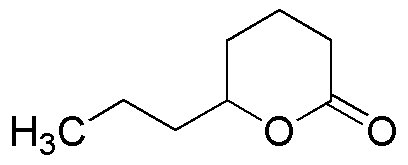d-Octalactone is widely utilized in research focused on
- Flavor and Fragrance Industry: This compound is commonly used as a flavoring agent in food products and beverages, providing a creamy, coconut-like aroma that enhances the sensory experience.
- Cosmetics and Personal Care: In the cosmetics sector, d-Octalactone serves as a fragrance component, contributing to the scent profile of lotions, perfumes, and other personal care products.
- Pharmaceuticals: It is also explored in the pharmaceutical industry for its potential applications in drug formulation, particularly in creating stable and effective delivery systems.
- Biotechnology: Researchers are investigating its use in biotechnological applications, such as in the production of biodegradable polymers, which can help reduce environmental impact.
- Aromatherapy: The compound is utilized in aromatherapy products for its calming and soothing properties, making it a popular choice in essential oil blends.
General Information
Properties
Safety and Regulations
Applications
d-Octalactone is widely utilized in research focused on
- Flavor and Fragrance Industry: This compound is commonly used as a flavoring agent in food products and beverages, providing a creamy, coconut-like aroma that enhances the sensory experience.
- Cosmetics and Personal Care: In the cosmetics sector, d-Octalactone serves as a fragrance component, contributing to the scent profile of lotions, perfumes, and other personal care products.
- Pharmaceuticals: It is also explored in the pharmaceutical industry for its potential applications in drug formulation, particularly in creating stable and effective delivery systems.
- Biotechnology: Researchers are investigating its use in biotechnological applications, such as in the production of biodegradable polymers, which can help reduce environmental impact.
- Aromatherapy: The compound is utilized in aromatherapy products for its calming and soothing properties, making it a popular choice in essential oil blends.
Documents
Safety Data Sheets (SDS)
The SDS provides comprehensive safety information on handling, storage, and disposal of the product.
Product Specification (PS)
The PS provides a comprehensive breakdown of the product’s properties, including chemical composition, physical state, purity, and storage requirements. It also details acceptable quality ranges and the product's intended applications.
Certificates of Analysis (COA)
Search for Certificates of Analysis (COA) by entering the products Lot Number. Lot and Batch Numbers can be found on a product’s label following the words ‘Lot’ or ‘Batch’.
*Catalog Number
*Lot Number
Certificates Of Origin (COO)
This COO confirms the country where the product was manufactured, and also details the materials and components used in it and whether it is derived from natural, synthetic, or other specific sources. This certificate may be required for customs, trade, and regulatory compliance.
*Catalog Number
*Lot Number
Safety Data Sheets (SDS)
The SDS provides comprehensive safety information on handling, storage, and disposal of the product.
DownloadProduct Specification (PS)
The PS provides a comprehensive breakdown of the product’s properties, including chemical composition, physical state, purity, and storage requirements. It also details acceptable quality ranges and the product's intended applications.
DownloadCertificates of Analysis (COA)
Search for Certificates of Analysis (COA) by entering the products Lot Number. Lot and Batch Numbers can be found on a product’s label following the words ‘Lot’ or ‘Batch’.
*Catalog Number
*Lot Number
Certificates Of Origin (COO)
This COO confirms the country where the product was manufactured, and also details the materials and components used in it and whether it is derived from natural, synthetic, or other specific sources. This certificate may be required for customs, trade, and regulatory compliance.

